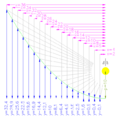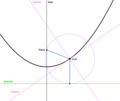What is a parabola?[edit | edit source]
A parabola is a unique geometric shape defined by its symmetrical, curved form, which has important applications in both mathematics and the physical world. This curve is characterized by its property of being equidistant at any point from a fixed point, known as the focus, and a fixed line, called the directrix.
A simple parabola with its axis of symmetry parallel to the y-axis with the vertex at (0,0) is:
and the focus of that parabola is at:
So, for a parabola such as y=x², with the a coefficient 1, the focus f is (0,¼).
-
Different parabolas with the same focus.
-
Table of x and ys with P (the focus aka f) set to 10. Note the European comma is the US period.
-
Parabolic shape calculation. Diagram of x and ys with P (the focus aka f) set to 10. Note the European comma is the US period.
-
Tool for drawing parabolas.
-
Parabolic basket and tin can solar cooker team drawing out a parabola.
-
The main mathematical labels of a parabola.
Length of an arc of a parabola[edit | edit source]
If a point X is located on a parabola which has focal length f and if p is the perpendicular distance from X to the axis of symmetry of the parabola, then the lengths of arcs of the parabola which terminate at X can be calculated from f and p as follows, assuming they are all expressed in the same units.
This quantity, s, is the length of the arc between X and the vertex of the parabola.
The length of the arc between X and the symmetrically opposite point on the other side of the parabola is 2s.
The perpendicular distance, p, can be given a positive or negative sign to indicate on which side of the axis of symmetry X is situated. Reversing the sign of p reverses the signs of h and s without changing their absolute values. If these quantities are signed, the length of the arc between any two points on the parabola is always shown by the difference between their values of s.
This can be useful, for example, in calculating the size of the material needed to make a parabolic reflector or parabolic trough.
(Note: In the above calculation, the square-root, q, must be positive. The quantity ln(a), sometimes written as loge(a), is the natural logarithm of a, i.e. its logarithm to base "e".)
Parabola technologies[edit | edit source]
Parabolas can be used for many things, for example solar cookers, solar turbines and antennas or waveguides for wireless transmission.
In these cases, some medium, for example sunlight or electromagnetic radiation, is being focused by the parabola. A single parabolic arc will create a focal line, whereas an elliptic paraboloid will create a single focus point. An alternative to paraboloids is to use two parabolas at 90° angles to each other, where one gathers the medium into a line and the other condenses the resulting line into a point. This is often easier to achieve with simple tools, but at a loss in efficiency. See Using Two Parabolic Troughs to Simulate a Paraboloid.
Parabolic solar cookers collect sunlight at the focus point, where it heats up and can be used for cooking. Similar parabolas are used to boil water in pipes (along a line) or in silos (at a focus point) to drive solar turbines (for boundary layer turbines it may be possible to use superheated air rather than water).
As antennas or waveguides, parabolas and paraboloids are highly directional. The FabFi project is an example of a system that uses paraboloid waveguides for directional wireless transmission.










